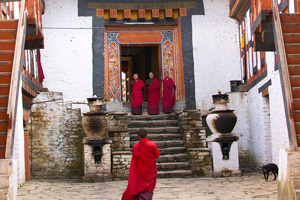Laya-Gasa Trek
- a great choice for a long and moderately hard trek at high altitude -
Days 1 and 2
Arrive Paro. Hike to Taktshang monastery as good acclimatisation for the trek
Day 3
Today we will do another acclimatisation hike at Chele La pass. We can also visit Kila Gompa nunnery.
Day 4 - Trek Day 1: Shana to Soi Thangthangkha
Early in the morning drive about 2 hours through farm road to Shana, where you will start your trek. We ascend through the river valley and beautiful pine and rhododendron forests. Sadly much of the forest has been cut to make way for electricity to be run to Jangothang and Lingshi – the sight of fallen trees is a reminder of the cost of progress. We turn north towards Mount Jomolhari, which can be seen from the top of the valley. Our camp will be at 3680 metres. (19 km, 8 to 9 hours)
Day 5 and 6 - Trek Day 2 and 3: Soi Thangthangkha to Jangothang and rest day at Jangothang
The trail continues to follow the river and passes a small army post where the valley begins to widen again. Views of high ridges and snow-capped peaks can be seen on all sides. At this altitude (about 4040 m) it is possible to see yaks and yak herders. Camp is beneath a ruined fortress at the base of Mount Jomolhari. (19 kms, 6 hours) Take a rest day at Jangothang where you can explore the glacier or visit nearby Tshophu lake.
Day 7 and 8 - Trek Day 4 and 5: Jangothang to Lingshi and rest day at Lingshi
The trail climbs gradually to Nyili La Pass (4680 m). Broad yak pastures can be seen along the length of the route. If the weather is clear, there is an excellent view of Lingshi Dzong as we descend into the Lingshi basin. Tserim Kang and its descending glaciers can be seen at the north end of the valley. We camp in a stone shelter at 3915 m. (19 km, 7 to 8 hours). On your rest day you can take a day’s excursion to Tsekha (Lahe), the base camp of Jichu Drake mountain where it is possible to see blue sheep and musk deer. (Altitude about 4500 m) If you prefer, you can relax today, explore the village and visit the school. Sadly Lingshi Dzong was badly damaged in a recent earthquake and it will only be possible to visit if renovations works are complete.
Day 9 - Trek Day 6: Lingshi to Chebisa
This is the shortest trekking day. Once we have reached our camp at Chebisa (3910 m) it is possible to visit some village houses and a waterfall just behind the village. (10 kms, 5 hours)
Day 10 - Trek Day 7: Chebisa to Shomuthang
The trail goes through wild pastures where yaks graze. We cross the Gobu La Pass (4350 m) before reaching Shomuthang. The camp (at 3985 m) is near a tributary to the Mo Chhu which emerges below the Gasa Tsachu (Hot Spring). From here you can see the helipad which is sometimes used if the passes get snowed in. (17 km, 7 hours)
Day 11 - Trek Day 8: Shomuthang to Robluthang
We start with a climb to Jhari La (4600 m) where we are rewarded with quite stunning views, then descend again through forest to Tsharithang, the valley where herds of takin can normally be seen. Today’s scenery is absolutely breathtaking. Cross the river and clamber up the hillside for an hour or so to camp at Robluthang (4160 m). (18 km, 7 to 8 hours)
Day 12 - Trek Day 9: Robluthang to Limithang
After reaching the Shinge La Pass (4870 m), the path descends and goes through the valley. Limithang is in the Laya district where the locals will be seen wearing unique regional dress. Our camp is at Kang Che Da beneath Gang Chen Ta, the Great Tiger Mountain, at an altitude of 4090 m. (19 km, 8 hours)
Day 13 and 14 - Trek Day 10 and 11: Lemithang to Laya and rest day at Laya
The path goes downhill through a winding river valley and enters the eastern end of Laya village. (Altitude 3820 m, 10 kms, 4 to 5 hours) Next day explore the village and meet local people. You may even get the opportunity to make a phone call or check email from here as the village is well linked up with telecommunications!
Day 15 - Trek Day 12: Laya to Koina
The trail follows the river valley and there is a breathtaking view of vibrant rivers, feeder streams and waterfalls. At Koena there is a hut to sleep in which is sometimes welcome if the fields are muddy. (3510 m, 19 km, 8 hours)
Day 16 - Trek Day 13: Koina to Gasa and on to Gasa Hot Springs
We cross the Bale La Pass (3740 m), after which the trail descends to Gasa Dzong (2900 m). Continue with a steep descent to the hot springs at Gasa at 2240 m. (18 km, 8 to 9 hours)
Day 17 - Trek Day 14: Gasa Hot Springs to Damji and on to Punakha
Walk through rolling hillsides with vistas of fields, villages and oak and pine forests. The trail descends from the high agricultural terraces above the Mo Chhu into a semi-tropical gorge, ending at Damji. (17 km, 6 hours). A car will meet us at the road head to drive to Punakha.
Day 18 and 19
Visit the imposing Punakha Dzong, “Palace of Great Happiness”. Built in 1637, it is strategically placed at the confluence of two rivers, the Po Chu and the Mo Chu. Then return to Thimphu over the Dochu La pass at 3050 metres where you can catch a great view of the Himalayan range that you have just seen at close hand. Sightseeing in Thimphu
Day 20
Depart








